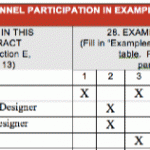Research is just one of those activities that most marketers don’t like doing. But many will agree it is also one of the most critical marketing tasks.
Maybe research gets a bad rap. Let’s not think about research as simply crunching numbers, there is a purpose to it. If you are not basing your marketing activities on research, you are basing them on luck. Luck works sometimes, but it’s not going to give you consistent results.
One of the challenges with research is that marketers often approach it the wrong way.
Many marketers either perform too little or too much research. Some perform marketing research without any idea of why they are doing it and what they are going to do with the data they collect. This approach will only lead to frustration and wasted time. Others track large amounts of data that they never use. Finding the right balance is important.
Unfortunately, AEC firms lag behind other industries when it comes to research. For example, the pharmaceutical industry does a significant amount of market research and leverages it using it’s sales force. When a pharmaceutical sales rep walks into your doctor’s office, they know exactly how many of their pills and their competitor’s pills your doctor prescribes, almost in real-time. But many marketers in our industry will walk into a potential client’s office with little to no research they can leverage to get someone to buy their services. Like any marketing activity, research needs to be planned and conducted with a clear objective in mind. The purpose of research is to answer the following five questions:
- What services did/does my firm provide to clients?
- What services can my firm provide to clients?
- What are our strengths/weaknesses
- What business opportunities are out there for us?
- How do clients procure our services?
Whether you are a marketing coordinator, chief marketing officer, or CEO. Being able to answer these questions will be critical to your success.
To some, this may sound like strategic planning, but it’s not. These are questions that have answers, it’s just a matter of finding them (A.k.a Research). Let’s look at these questions in more detail.
What services did/does my firm provide to clients?
Most marketers walking into a AEC firms for the first time realize that there is a lot to learn about the business. But if you are moving to a new firm from a firm with similar services, it’s easy to feel like you already have a handle on this topic. But chances are you don’t. As a marketer, you need to understand your firm’s history of providing services. You need to have a thorough understanding of what they did and who they did it for. You need to be able to “tell the story of your firm.” This is not a research task that will take you hours. Most likely, it will take you days or months before you have the understanding of your firm’s history needed to do this.
When I first interviewed for the firm I work for now, the Marketing Director at the time walked me through the office, introduced me to the engineers, told me all about the history of the engineering firm, and how they work with “as-builts.” I only asked one question: “If this is an engineering firm, where are all the drawings?”
“Oh, we are not that kind of engineering firm,” she said. To her, an as-built was a schedule. To me, it was a drawing. Even the most seasoned marketer can sometimes have trouble explaining what exactly their firms do.
To start your research in this area, designate specific time to read through all your firms marketing materials, proposals, qualification packages, databases, etc. Sit down with project managers and senior professionals and ask to hear the stories behind the assignments. You need to be capable of teaching a college level course on your firm and what they’ve done.
Another important area of research is to look at your firm’s project history from a revenue perspective. What sectors, services, or clients bring in the most or best revenue? Some accounting systems will be able to spit this information out for you. But even if yours doesn’t, you can easily put a spreadsheet together of projects and what your firm billed on them. Then it’s just a matter of connecting marketing information (services, client, sector) to the billings spreadsheet. I suggest starting by evaluating one, three, or five year periods. If you talk to the staff you can even add information like the origin of each project. Then you can assess what activities bring in revenue. This information can prove useful when you determine which activities you should concentrate your efforts on.
I worked with a senior business developer who had an impressive resume and decades of relevant industry experience under his belt. But after a year at my firm, it was clear that he still did not have a solid understanding of what exactly we did. His excuse was, “Well, I’ve only been here a year.” Unfortunately for him, having been at a firm a year is not the time to be learning it, it is the time to know it. He was ultimately let go. I can’t stress enough the importance of developing a strong and complete understanding of what your firm does/did.
What services can my firm provide?
There is sometimes a big difference between what a firm can do and what a firm does. This can become an area of great risk or great reward for a firm. For example, I worked for a mechanical/electrical/plumbing designer who told a large state university that they could manage one of their construction projects. While it seemed like a good idea at the time, nobody in the office had substantial construction management expertise and the project quickly turned into a disaster. The client wasn’t happy and it’s safe to assume they will never use that firm again.
However, It doesn’t always turn out bad. When you can make an honest assessment of what your firm or office can do vs what it does, you can often tap into unrealized revenue streams. An example is a consulting firm that was asked to provide an assessment of procurement practices in a whistleblower case. While this wasn’t the firm’s “bread and butter,” they had the people with the specific skill-set to perform this task successfully.
Once you understand what your firm does, delve deeper into the staff’s professional history, technical skills, and resources to learn what they can do. A firm’s potential is tied closely to it’s staff. If you were working for me, your first day would consist of calling each and every staff member in each and every office to introduce yourself and learn more about them. Learning about the technical staff is important enough to be a day one activity.
What are your firm’s strengths/weaknesses?
When I started working for a commercial real estate company, one of the first tasks I was given was to call our competitors and ask them about our firm. So, i sat down at the phone for close to two days and did exactly that. The point of this exercise was to determine our firm’s strengths and weaknesses as seen by our competitors. Strengths and weaknesses are perceptions. You may think you have the most detailed and accurate drawings, but if the perception is that you don’t, it’s more of a weakness than a strength. You have to reach outside your doors to truly understand your firms strengths and weaknesses.
Many AEC firms would never dare to do this. But one very successful executive I know took this approach to a new level. Upon being asked to head up a national design practice, she flew around the country, sitting down with direct competitors, freely sharing information and ideas. She learned much more about the market sector and her practice then she ever would have inside the comfort and bubble of her internal team.
Client surveys are another great source of information. Unfortunately, many firms choose either not to conduct them, only survey the “happy” clients, or conduct the surveys through internal project managers. Not conducting client surveys is a mistake because not only are you missing a great opportunity to gain valuable client feedback, you are losing the opportunity to mold perceptions in your favor. If you only survey the happy customers, you are creating a perception of reality that might not exist. It’s important not to lose sight of reality, even when that reality is not as pleasant as you would like. Because many clients might hesitate to be honest and hurtful to your face, an outside service is one of the best ways to conduct a client survey.
I worked with a project manager that all the clients loved. After he left the firm to start his own business, we had an outside consultant conduct a survey of our clients. What we found is that while clients liked this guy’s personality, they hated his performance and lack of responsiveness. Even years later, in a thriving economy i heard that office shrunk to half it’s size and had to move to a much smaller office space. Poor client service, and more importantly negative client perceptions can be devastating to an AEC firm.
This type of research is sadly not very common. Many firms fail to really find out what their strengths and weaknesses are. Unfortunately, to their own detriment.
What business opportunities are out there for us?
This is the most obvious area of marketing research. Marketers are always on the look out for new business opportunities. Research in this area can include looking for request for proposals (rfp) or leads from lead services. Marketers who chase work with government agencies will find the most use of these services. Some of the more affordable examples include:
- Www.govcb.com
- Www.fedbizopps.gov
- Www.stateandfederalbids.com
You can also find rfps published in local and regional newspapers. Many times government institutions like public universities are required to publish rfp announcements in the local newspaper.
Many people argue that if the rfp is “on the street” (i.e. publicly available), it is too late to develop a winning proposal or team. I don’t necessarily agree with that, having been successful winning contracts in this manner across the country. Therefore, I recommend using lead services. But I advise that you use them wisely. This means forwarding relevant rfps to your contacts and having some clear go/no go guidelines to stop you from going after assignments you simply have no shot of winning.
This leads into the next area for opportunity research, news and gossip. If you are specifically targeting a public agency or corporate client, you’ll need to do research into the company or agency goings on. Sometimes you can get information from people in your professional network (this will be more thoroughly explained later). I also suggest setting up a google alert that searches the web and emails you the latest developments of the company or agency. You can set up a google alert at
www.google.com/alert
The web in general is a great source of research data. If you spend just a little time honing your search engine skills, there is a wealth of information available at your fingertips.
How do clients procure our services?
Many people believe that clients, especially government agencies procure work through open and fair procurement. This is simply not true. That’s why it’s so important to learn how a client procures your services. Large corporations will often have a rotating stable of consultants they go to. Whether you win work may have more to do with if it’s “your turn” than the quality of your proposal. On the government side of things, you have to consider how time consuming and costly open procurement is. Many agencies find ways around open procurement. Public agencies have awarded contracts worth millions without openly bidding them. While all of this is true, there are still more than a few procurements out there that are open and fair.
For some, like me, it’s often hard to accept the dual nature of procurement. I expressed this uneasiness one time in an exit interview. I explained to my boss, the Senior Vice President, how disillusioned I was after submitting what I , to this day, consider the worst proposal ever. Sloppy was not the word for it, it was simply and utterly atrocious. There were mistakes on nearly every page, the worst being I had the wrong spelling of the company’s name we were submitting it to. But what was so disillusioning about it wasn’t the quality of the proposal, it was that we had won. And the amount of work was not insignificant. What was the purpose of my job if the quality of my work did not influence the outcome?
“Well, that guy owed me a favor,” my boss explained.
It can be hard to come to grips with the dual nature of procurement. And I can’t help to see myself in less seasoned marketers who find themselves faced with this harsh reality. It’s natural to assume things should be fair. When dealing with government agencies, you also have to research their procurement process. For example, You will need to be pre-qualified with many agencies before you can work with them. Sometimes you need to be pre-qualified to even learn about agency rfps. If you get your hands on an rfp, you may not have enough time to go through the pre-qualification process before the proposal is due. Therefore, it is important to understand each agencies pre-qualification process and do what needs to be done before you should have done it.
Conclusion
There you have it. You can conduct market research for your AEC marketing efforts that you can be proud of by just simply answering a few key questions. Are there any other market research questions you should answer? Leave a comment with yours!





[…] Conduct AEC Market Research You Can Be Proud Of […]